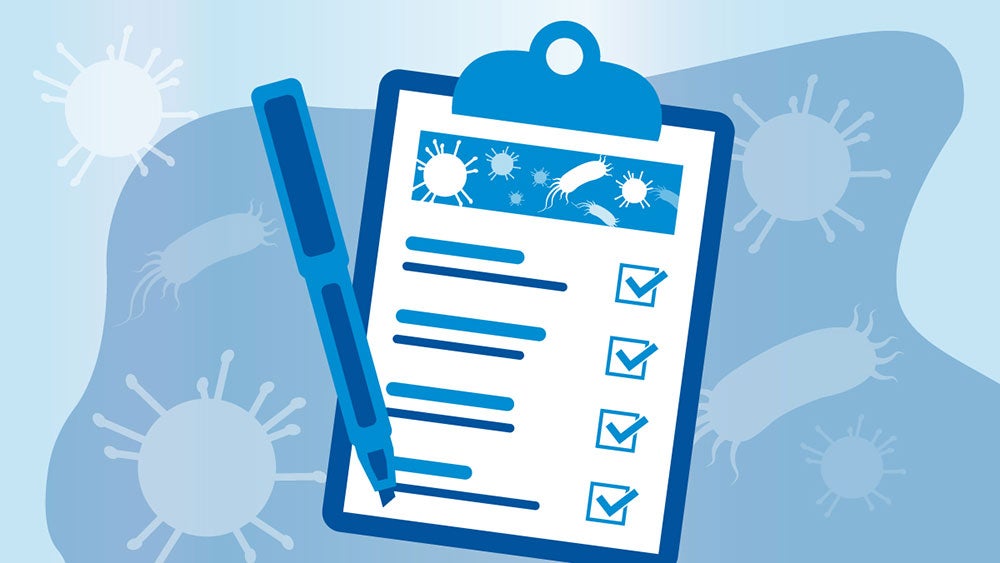
Norovirus is a highly contagious virus that often causes outbreaks during the winter months, and this year has been no exception. From August 1, 2022, to February 12, 2023, NoroSTAT, a collaborative network of state health departments and the CDC, reported 254 norovirus outbreaks in participating states, including a multistate outbreak in Alabama, Florida, Georgia, Louisiana, Mississippi, North Carolina, Tennessee, and Texas.1,2 Each norovirus outbreak can affect many individuals3, as seen in the several K-12 schools4,5 that have already been forced to shut down due to high numbers of norovirus cases this year.
As the norovirus season typically lasts until April, it is crucial to take preventive measures to help break the chain of infection.6 As a cleaning manager or supervisor, you also have an essential public health role in managing and preventing the spread of infections, including norovirus. While outbreaks can be stressful, there are several things you can do to help.
To assist you in managing the current norovirus outbreak, I have compiled a checklist of key questions with tips to follow. This guide will enable you to manage the situation effectively and easily, and by checking off each item, you will gain the confidence that you are helping to prevent and manage the spread of norovirus.
Key questions to answer during an outbreak
- What is the outbreak germ and how is it spread?
- The CDC is the best place to start learning about outbreak germs.3 Manufacturers often create relevant education material about outbreak germs too that can be useful.
- In the case of norovirus, it is a difficult to kill virus and it can spread easily from person to person in multiple ways.
- Importantly, it spreads easily from surfaces when an infected individual touches a surface contaminated with fecal or vomit particles with their bare hands or through the spattering of vomit or diarrhea onto surfaces. The virus can also be spread when tiny particles of vomit travel through the air and settle on surfaces or are ingested by another person.
- Are your building occupants and staff more susceptible to infection than the average population?
- Not everyone’s immune systems are created equal and there are some populations that are more susceptible to infections than others. In the case of norovirus, the young and elderly are the most vulnerable, and other susceptible populations include pregnant women, chemotherapy patients, and transplant recipients.
- If your building occupants, visitors, or staff are in any one of these categories, your role is even more important.
- Since only a few viral particles are needed to cause illness, it is a good idea to disinfect all shared surfaces, not just those “commonly touched”.
- Is your cleaning and disinfecting product EPA-registered to kill the outbreak germ?
- All disinfectants require EPA-registration in the United States, and products used against norovirus on surfaces should indicate this on the label. Because human norovirus is challenging to test in a laboratory environment, EPA-approved products have been tested against surrogate viruses, such as “feline calicivirus” or “murine norovirus,” which are thought to be similar in how difficult they are to inactivate on an environmental surface.
- In addition to the EPA-registration against the outbreak germ, contact time is another attribute not to overlook. Look for products with low norovirus contact times to ensure efficacy (otherwise, your team may be wasting their time).
- While bleach-based products are often used for norovirus, do not assume that you must use them. If you look, you may be surprised to discover that even some eco conscious disinfectants have norovirus claims with short contact times!
- Do you need to increase the scope or frequency of cleaning and disinfecting in your facility?
- Review your facility risk assessment to help you make decisions on how to adjust your team’s work. Although many of the same daily tasks still need to be performed, surfaces that are usually lower risk may need to be cleaned and disinfected more often during the outbreak.
- If building occupants can help share some of the responsibility (beyond helping by washing their hands and staying home when sick), include the purchase of effective EPA-registered disinfecting wipes (with a norovirus claim of course) and place them in high-touch areas. Use signage to teach building occupants how to use products effectively and safely.
- Do you have enough product to effectively clean and disinfect during the outbreak?
- An easy way to do this is track the amount of product used during the first week of implementing your new protocols.
- Then, adjust the quantity ordered each time to accommodate the new volume.
- Do you need to provide staff with additional PPE based on how the outbreak germ spreads?
- Because norovirus can spread by surfaces and in some cases through the air (when someone nearby vomits), appropriate PPE to protect front line staff during a norovirus outbreak includes masks and gloves.
- When staff are introduced to new PPE, make sure they are trained on how to put it on, take it off, and wear it so it is effective while working.
- Does your staff need to be educated and trained on a new product and/or protocol?
- OSHA requires that staff are trained to use products safely and effectively. To do this, read the labels thoroughly and observe staff using the product correctly. Most manufacturers will offer directions for use product training to help free of charge.
- Be sure to document your training just in case you are asked to show the evidence during an inspection.
- It’s also a good time to assess and implement additional staff competency training.
- Do you have enough staff to address the additional frequency?
- It goes without saying that more work means that either something else must give, or more people are needed to do the job effectively and safely.
- An example tasks that may be put on hold during an outbreak are some deep cleaning or project work. Equipment maintenance tasks should never be postponed, however.
Congratulations you successfully managed the outbreak! Now what?
- Completing the norovirus outbreak checklist is a significant accomplishment, but do not keep it to yourself! Share it with upper management, staff, and building occupants to show them what your organization is doing to help keep them healthy and safe.
- While this outbreak may not last forever, another one is just around the corner. Save and bookmark this guide so you can use it again when you need it and, after the current outbreak is over, take the time to evaluate what worked and what didn’t. This will help you make necessary adjustments and improvements for future outbreak management.
By taking these steps, learning from past experiences, and implementing the checklist, your team can be better equipped to help prevent and manage the spread of norovirus and other infections.
References
1. NoroSTAT Data [Internet] CDC. [cited 2023 March 9] Available from: https://www.cdc.gov/norovirus/reporting/norostat/data.html
2. Multistate Norovirus Outbreak Linked to Raw Oysters from Texas. [Internet] CDC. [cited 2023 March 6] Available from: https://www.cdc.gov/norovirus/outbreaks/index.html
3. About Norovirus [Internet] CDC. [cited 2023 March 9] Available from: https://www.cdc.gov/norovirus/about/index.html
4. Classes canceled at Livonia school following norovirus outbreak [Internet] The Detroit News [cited 2023 March 9] Available from: https://www.detroitnews.com/story/news/local/wayne-county/2023/02/11/classes-canceled-at-livonia-school-following-norovirus-outbreak/69895463007/
5. At Least 130 Sick in Norovirus Outbreak at Las Vegas School [Internet] The Food Poisoning Bulletin [cited 2023 March 9] Available from: https://foodpoisoningbulletin.com/2023/at-least-130-sick-in-norovirus-outbreak-at-las-vegas-school/
6. Norovirus Illness: Key facts. [Internet] CDC. [cited 2023 March 7] Available from: https://www.cdc.gov/norovirus/downloads/keyfacts.pdf






